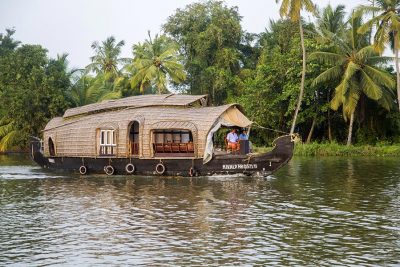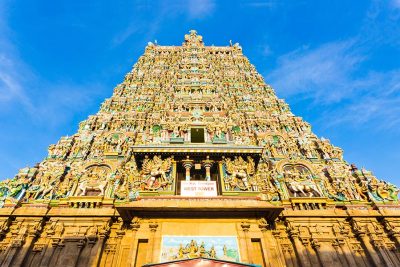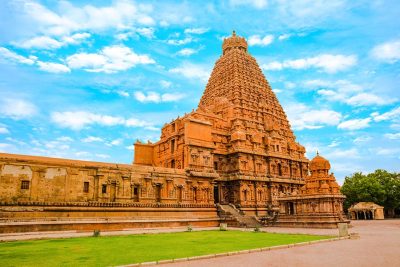The South India’s essence
Tour in India – 12 days
The itinerary here proposed is an unusual and innovative path to discover the most extraordinary places and the natural and cultural variety of the South of India. You could admire the most famous and noted temples of Tamil Nadu and, at the same time, you could dive in the cultural heritage of these peoples. The tour will start in Chennai (before Madras) and it will ends in Malabar, coastal region of Kerala.
The first stop will be the ancient city of Madras, now known as Chennai. Here you can visit the Kapaleeshwarar temple, dating back to the 7th century. On the way to Mahabalipuram, you will stop at Dakshinachitra, an NGO committed to the conservation of South Asian arts, traditions and architecture. We will continue on to Mahabalipuram, a thriving port city of the Pallava dynasty, famous for being a real museum of sculpture in the open air.
From here you will move to discover one of the holiest cities in India, Thiruvannamalai, where you will visit the sacred places of one of the most important masters of India, Ramana Maharshi. In Pondicherry, you will visit the international community of Auroville, with its renewable energy projects, organic agriculture etc.
On the way to Kumbakonam, you will move to Chidambaram. Here you will visit the only temple in India dedicated to Shiva Nataraja (Shiva Dancing). It is also one of the few temples that follows Vedic rituals, including the Yajna or fire sacrifice.
The next stop will be the ancient city of Kochi, where you will find several Hindu temples, one of the most important is the Ernakulam Shiva, dedicated to Shiva and located in Ernakulam, in the eastern part of the city. Other major temples are the Ettumanoor Shiva, the Chottanikkara, the Kaduthuruthy and the Poornathrayesa, passing through the Periyar National Park, one of the most beautiful in India, located in Theddaky.
The last stop will be Kumarakom, where we will have the opportunity to participate in the responsible tourism initiative called ‘Village life experience’, which consists of a half-day package that allows you to experience life in an authentic village in the bakwaters.
PROGRAM OF THE JOURNEY
1° DAY: ARRIVAL IN CHENNAI
Chennai
Arrival in the morning at Chennai’s airport, meeting outside the terminal with one of our operators and transfer to the hotel to rest. In the late morning, visit of the city. The Kapaleeshwarar temple, dating from the 7th century, is a sanctuary, located in the Mylapore area; it is dedicated to Shiva, with the name of Arulmigu Kapaleeshwarar. It is in the Dravidian style, with the Gopura (ornamental tower) overlooking the street where the temple stands. In Mylapore there is also a Roman Catholic church, the Basilica of St. Thomas, built in the 16th century by Portuguese explorers on the site of the tomb of the apostle of Jesus. (Only for groups, in the afternoon there will be the possibility to discover a local NGO that cares for children in slum areas and their communities, primarily by providing good education and vocational training). Overnight in Chennai. (B)
2° DAY: VISIT OF MAHABALIPURAM
Chennai – Mahabalipuram – Thiruvannamalai
After breakfast, transfer to Thiruvannamalai. On the way, visit to Dakshina Chitra, an NGO that works to keep the arts, crafts and traditional architecture of South India alive. Two-hour guided tour of the city’s hystorical buildings, exploring every corner. Possibility of having a direct experience of art or crafts. Afterwards, transfer to Mahabalipuram. Also called Mamallapuram, the town dates back to the 7th-9th century, during the reign of the Pallava dynasty. The buildings, almost all carved from granite, are among the oldest examples of Dravidian architecture. Visit to the temple on the beach, the oldest structure in the area, built in the eighth century; to the Pancha Rathas (the 5 chariots), 5 monolithic pyramidal structures flanked by huge animal sculptures, including an elephant; to the Thirukadalmallai temple, dedicated to Vishnu, built by King Pallava to protect the sculptures from the ocean. In the late afternoon, transfer to Thiruvannamalai and check into the hotel for dinner. Overnight in Thiruvannamalai. (B, D)
3° DAY: VISIT TO THIRUVANNAMALAI
Thiruvannamalai
After breakfast, visit to Thiruvannamalai. This is a place off the beaten track but (also for this reason) of great interest. Tiruvannamalai (literally: “the red mountain”) is one of the 5 most important sacred cities of Tamil Nadu and is consecrated to the cult of fire (an element representing Lord Shiva). It is not by chance that it rises on the slopes of the ancient Arunchala volcano. Visit to the main temple of Arunachaleshvara, which dominates the city (every December, on the night of the full moon, a suggestive Hindu festival is celebrated during which the slopes of the Arunachala volcano are illuminated with large bonfires). The most evocative view of this huge complex is by climbing towards the meditation caves of Shri Ramana Maharishi, a great teacher and saint who lived in this location until 1922. You will have the possibility of visiting the ashram, the home of the modern sage, Sri Ramana Maharshi. He lived in this place for about 28 years, from 1922 until his death in 1950. Ramana Maharishi’s Samadhi is a pilgrimage destination for believers. The ashram is located at the foot of the Arunachala hill and is surrounded by lush nature. Overnight in Thiruvannamalai. (B, D)
4° DAY: VISIT TO PONDICHERRY
Thiruvannamalai – Pondycherry
After lunch, transfer to Ponndicherry. With its waterfront, wide streets, the French cultural and architectural legacy, and the popular Ashram, Puducherry (original name) is a one-of-a-kind Indian city. The previous French colony was founded in the early 18th century as a colonial enclave, and over time the French style was superimposed on the characteristic Indian style. Consequence is the cultural and architectural richness. A guided tour will show you the major tourist attractions such as the Ashram founded by Sri Aurobindo in 1926 and then entrusted by him to his disciple ‘The Mother’; the Church of the Sacred Heart of Jesus and the Bharti and Bharthidasan memorial museum. The Pondicherry district is also the birthplace of some notable personalities such as the poet Subramanya Bharathy and the director M. Night Shyamalan. Overnight in Pondicherry. (C)
5° DAY: VISIT TO AUROVILLE
Pondicherry – Auroville – Pondicherry
Transfer early in the morning to Auroville, which shows itself as an international town where men and women of every country can live in peace and harmony, overcoming religious, political and cultural differences. Born in 1968, it is a constantly evolving project. At 8:30 at the visitors center you’ll see an explicative video and then discover the heart of the city, the gardens of Matrimandir, a wonderful modern architecture with a golden globe 30 mt high with lotus urns at the base. The tour continues with a visit of two hours about Sri Aurobindo and Yoga, and with a bicycle tour to discover Auroville.
During the tour the Auroville Charter which acts as a silent guide for the inhabitants of the town and the various projects pursued will be illustrated: architectural projects for its expansion, agricultural projects for sustenance and financial projects to experiment new solutions for the future. Overnight stay in Pondicherry (B, L).
6° DAY: VISIT TO CHIDAMBARAM
Pondicherry – Chidambaram – Kumbakonam
After breakfast departure for Chidambaram. Visit to the temple of Chidambaram, the only temple in India dedicated to Shiva Nataraj, the dancing Shiva. Transfer to Kumbakonam, called the city-temple or the city of temples, given the high number of temples built inside and around the city. Check-in at the hotel. Later visit the Dharasuram village, located 3 km from Kumbakonam, known for the Airavateswara temple, also built under the Chola dynasty in the 12th century. The temple is dedicated to Airavata, the white elephant from Hindu mythology that carries the god Hydra. Both temples were declared a UNESCO World Heritage Site in 2004 and are majestic examples of the dynasty’s architectural mastery.(Only for groups, in the evening performance of Bharathanatyam with traditional vegetarian dinner). Overnight in Kumbakonam. (B, D)
7° DAY: VISIT TO KUMBAKONAM
Kumbakonam – Tanjore – Madurai
After breakfast, transfer to Madurai. Stop along the way to visit the Brihadishvara temple in Tanjore. Also known as Thanjavur, it was a Chola city and gained importance under this dynasty between the 11th and 14th centuries. According to legend, the name derives from Tanjan, the name of an asura demon from Hindu mythology, who was killed by Vishnu and Sri Anandavalli Amman for having devastated the area, but who was allowed to name the city as a last wish before to die. The temple was built at the behest of Emperor Chola Raja Raja and shows the liveliness of Indian architecture. It is a favorite pilgrimage destination for visitors to the city. After the visit, transfer to Madurai and check in at the hotel. Guided tour of Madurai and to see the main attractions: the royal palace; the Sri Meenakshi temple, dedicated to Shiva, here called Sundareshvara, and his consort Parvati or Meenakshi, which attracts many people from different parts of India; the Alagar Koil temple, dedicated to Vishnu. Overnight in Madurai. (D)
8° DAY: VISIT TO MADURAI
Madurai – Periyar
Early in the morning, possibility to visit Sri Meenakshi temple. After breakfast, transfer to Periyar (approximately 5h). Check-in at the hotel in Thekkady. Visit to the Periyar Reserve which covers an area of 777km2. It is one of the 27 tiger conservation reserves in India; in 1982 its innermost area, inaccessible to tourism, was elevated to the rank of National Park. It is considered an example of the bounty of nature which, with its countless panoramic views and rich bio-diversity, offers a beautiful experience to visitors. There are eco-tourism projects run by local people, responsible for the surveillance of the most vulnerable areas of the reserve. Free time to relax, stroll and enjoy the park. Overnight in Periyar. (B, D)
9° DAY: TRANSFER TO KOCHI
Periyar – Kochi
After breakfast, possibility of trekking along natural paths that go into very different habitats. The start is about 7 o’clock and lasts about three hours, the groups can have a maximum of 5 people and will be accompained by a local guide. The routes are 4-5 kilometers long and offer the opportunity to observe birds, butterflies and wildlife and to discover the incredible natural variety of the area, passing through evergreen or deciduous forests interspersed with swampy grasslands. After lunch, transfer to Kochi (about four hours) and check-in at the hotel in the ancient quarter of Fort Kochi, a very charming place, with its european heritage and a cosmopolitan attitude. Free time to stroll through the streets of the city to discover its natural harbor and historical sites. Overnight stay in Kochi (B).
10° DAY: VISIT TO KOCHI
Fort Kochi
After breakfast, guided tour of an half day in the city to discover the Jewish town, the synagogue, the spice market, the Mattancherry Palace, also noted as Dutch Palace, the St.Francis Church, the most ancient European church of India, the Cheena Vala, typical Chinese fishing nets (the only place outside of China where they are used). Return at the hotel. Free time for the rest of the day. In the evening, dancing exhibitions in a local theatre. You will have the opportunity to see traditional art forms such as Kathakali, a form of the eater-dance with very elaborate costumes and movements. Overnight stay in Fort Kochi (B).
11° DAY: VISIT TO THE BACKWATERS DI KUMARAKOM
Fort Kochi – Kumarakom – Kochi
Early in the morning transfer to Kumarakom (1 hour) for a day cruise in Kerala’s most beautiful Backwaters. Another major tourist attraction is the bird reserve which spans more than 14 acres. Agriculture, fishing and tourism are the major economic activities of the city, declared in 2005 Special Tourism Zone by the government of Kerala. Participation at the conscious tourism initiative called the ‘Village life experience’, which consists of a half-day package that allows you to live the experience of life in an authentic village.
It is a way to include in the itinerary a tourist service linked to local communities, according to the principles of conscious tourism. After lunch, return in Kochi. Free time and the possibility to undergo ayurvedic treatments. Overnight stay in Kochi (B,L).
12° DAY: TRANSFER TO KOCHI’S AIRPORT
Transfer to Kochi’s airport and departure with international flight.
ACTIVITIES
- visit the majestic and beautiful temples of Tamil Nadu;
- visit the projects dedicated to children in Chennai (for group tours only)
- discover the traditional architecture, the local crafts and the culture of the South of India in Dakshina Chitra;
- visit the sacred city of Thiruvannamalai and the meditation caves of master Ramana Maharshi
- get in touch with the international community of Auroville and its sustainability projects;
- explore the ex French colony of Pondicherry;
- visit the only temple dedicated to Shiva Nataraj in Chidambaram
- watch a Bharathanatyam dance exhibition in Kumbakonam;
- visit the famous temple of Meenakshee in Madurai;
- stroll in the Periyar nature reserve
- explore the ancient city of Kochi
- Experience a cultural program that includes 7 artistic forms: Kathakali (theater-dance), Mohiniyattam (traditional dance), Bharathanatayam (theater-dance), Kalaripayattu (martial art), Theyyam (ritual dance)
- take a responsible cruise on Lake Vembanad, experience village life and observe migratory birds
- attend performances and cultural activities;
- visit archeological and historical tourist sites.
SOCIAL AND ENVIROMENTAL IMPACT
All the itinerary in the South of India has been designed in order to promote direct or indirect benefits for local communities, environment and cultural heritages. When possible, we have selected traditional accommodations sensible to social and environmental issues, following general principles and practices of responsible tourism, including hotels that have been created with the specific intention of generating a source of financing for the social, cultural and economic development of the rural areas in which they arise. One of the fundamental prerogatives of these hotels is that they develop always keeping in mind the pre-existing context of the villages, with their culture, traditions, lifestyle, habits and above all talents and knowledge. Both the INDeco’s group and the Neemrana’s group they take care of restoring the historical properties of India to preserve them and to enhance the cultural heritage of the country. The Neemrana’s group likes to define its structures hotel not-hotel because no one of them it has been built with this purpose. In fact, these are monuments of historical importance (from the fourteenth to the twenty-first century) that tell different moments of the glorious Indian history. The restoration has given a new meaning to the word hospitality, transforming stays into unique experiences, which show the most authentic India and create job opportunities for young locals. Many of the activities and the visits included in the tour in the South of India will allow you to know the local culture and the actions undertaken in favor of marginalized communities. A special attention is dedicated to the promotion of children’s education and rights and to the activities for the protection of the environment and for the promotion of alternative livelihoods for local communities. The Dakshinachitra ONG, near Mahabalipuram, works to preserve the arts and the traditional handcraft. Its name means “an image of the south” and in fact, it is a living museum where arts, architecture, lifestyles and crafts typical of South India cross. It is possible to visit 18 historic buildings, from different areas of the country, which have been saved from demolition, interact with local artisans and attend theatrical performances and traditional dances. In Pondicherry you’ll visit the international city of Auroville, discovering the innovative sustainable development projects. While visiting the local village you could know the traditional shrimp fishermen. Both in Pichavaram and in Kumarakom the boats used belong to the local communities, which will receive fair compensation. In Kumarakom, you will participate in the “Village life experience” initiative managed by the Nodal Agency for responsible tourism in Kerala. Among the many places where conscious tourism was started by the government, Kumarakom is considered the most successful. Moreover, with a contribute of 70 euros, you could support the development of the projects in favor of one of the most marginalized tribal communities in southern India, the Kattunayakan community of the Nilgiri district in the states of Tamil Nadu and Kerala. The projects supporting these tribes focus on two main aspects: the protection of biological and cultural diversity and the promotion of regular education for the children of the community.
TIPS FOR THE JOURNEY
During the journey it is advised to follow a conduct which respects local culture to avoid any hassles or unwanted troubles along your journey. In particular, avoid displays of affection in public places, such as hugging, kissing etc., as this behavior is not appreciated by local people. Smoking is considered offensive and is punishable by law. Although this news may surprise, in Kerala there is a ban on smoking in public places. If you are a smoker, remember that you can only do so in your room, if permitted by the hotel.
It is also important to follow a certain dress code. There are basically two reasons why it is recommended to be careful about what clothes you wear here. The first reason is to avoid hurting local people’s feelings and second is to protect yourself from the unstable weather conditions. Besides, mosquitoes are a huge issue and it is advised to keep your arms and legs covered ( don’t forget to bring mosquito nets and repellents, especially for backwaters cruises).
India’s time zone is +5:30 hours, so you could have some problems with the jet lag. It is advised that you get onto this time zone as soon as you leave home and try to eat and sleep according local time. Also, if you reach India early in the day, try to stay awake – this will help the body’s internal clock to reset.
A conscious approach to travel requires a considerable capacity and willingness to adapt and adjust to the local environment and culture. If you wish to travel with us, we request you to be open enough to experience local culture, religious and traditions without bias and preconceptionsyou might have before the departure and which belong to our Western cultural way of thinking.
Exploring with fresh eyes, with patience and openness, you will be able to access the real essence of Sri Lanka’s cultural heritage through the places and people you meet. With this little effort, you will truly enjoy the beauty of a totally different culture, the wonder of nature, the solemnity of Dravidian’s temples and palaces, of the sacredness of the waters of the infinite rivers that flow through this magical land.
HOTELS
We selected beautiful and traditional heritages resorts with all the facilities throughout the tour. When possible resorts have been selected carefully according to criteria of social and environmental impacts. In Madurai and Kochi the accommodations are traditional city hotels complete with all services.
TRANSPORTS
Private vehicles or mini-buses with air conditioned according to the number of participants for all the transfers from Chennai to Kochi; ride on bicycles in Auroville.
WHEN TO GO TO INDIA
The climate in both states is essentially tropical. The highest temperatures, above 40 ° C, are recorded from April to June. The coldest period is between December and January, but in particular on hilly areas such as Ooty, Kodaikkanal and Yercaud, where the temperature can reach 5 ° C during the night. The best period is from October to March, especially for Kerala, which is hit by monsoons from June to September. Although most tourists avoid this period, visiting Kerala during monsoons is a fantastic experience.
COST OF THE TRIP
Itinerary available for:
Group Tours
Private trips (at least 2 people)
Honeymoon
COST FOR A PRIVATE TRIP
Fee calculated on a group trip with 2 registered persons:
€ 1.330 per person + Flight (not included)
THE PRICE INLCUDES
- accommodation;
- food according to the program;
- Italian speaking guide for 4 people or more;
- English speaking guide for 2 to 3 people;
- Backwaters cruise;
- transports with air conditioning;
- entrance tickets;
- activities;
THE PRICE DO NOT INCLUDES
- international flights;
- medical and baggage insurance (compulsory)
- travel cancellation insurance;
- visa;
- possible entrance tickets for camera;
- any tips and personal expenses;
- beverages;
- anything not specifically mentioned in the cost list includes.




